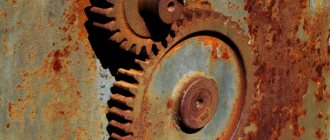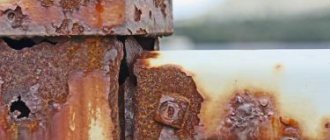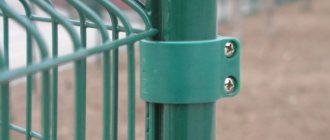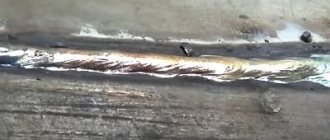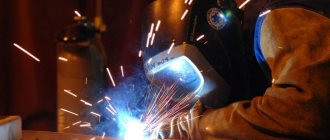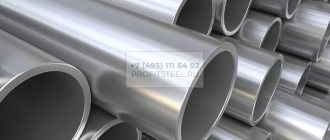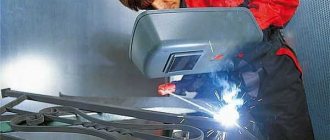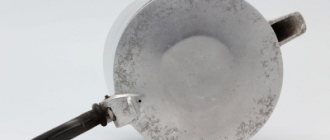Metal surfaces are often subject to corrosion for many reasons - from contact with humidity, other metals, and aggressive environments. There is a danger regardless of the place of use - both indoors and outdoors.
In this material we will look at the main methods of dealing with this problem and ways to remove corrosion that has already appeared. This will allow you to apply a protective coating or inhibitor on top, which will significantly extend the life of the steel part.
Manual processing as an effective method of combating corrosion
The main feature of the manual method is that during the cleaning process special tools are used without connecting to an electrical outlet. Usually this method alone is not enough to cope with rust, so additional means are used.
If you want to remove corrosion products, you can use a wire brush, spatulas, or sandpaper with coarse abrasive. Hammers help fight dense deposits.
Corrosion Damage
The type of corrosion damage depends on the material of construction, the presence of non-condensable gases, and the method of collecting and discharging the steam condensate.
Carbon steel
For carbon steel (CS) equipment, the presence of oxygen in the condensate typically creates pits that are often filled with corrosion products.
The presence of CO2 creates a mesoid type attack or deep groove. Corrosion products are often carried away with the escaping condensate and can settle elsewhere in the system where the flow rate is lower or the pressure is reduced.
Copper and Nickel
Copper-nickel heat exchange tubes can suffer from flaking when thin layers of metal in the tube turn into oxides.
Oxygen is primarily responsible for this type of damage, but other gases such as CO2 and ammonia help determine the extent and morphology of corrosion damage.
The slight slope typically given to horizontal tubes in heat exchangers (with steam on the shell side) can encourage condensate to flow toward one side of the baffle or tube support plate. This localized flow can create deep grooves in pipes immediately adjacent to the baffle or support plate. Brass tubes are especially susceptible to this form of attack.
Mechanized metal processing
When carrying out such cleaning, special installations are used. They are based on abrasive material or special scrapers.
The main advantage of processing using such material is that the equipment is equipped with a special electric mechanism. As a result, the process is significantly accelerated and the result becomes much better. The standard method for removing corrosive deposits is by rotating or reciprocating movements.
Why do metals break down?
When the non-condensable gases oxygen and carbon dioxide (CO2) are present in a system, alone or in combination, they can make hot condensate very corrosive.
These gases enter the steam-condensate system in several ways:
(I) together with boiler feed water in the form of “free” or entrained gases;
(ii) when steam condenses, a vacuum is created and air is drawn in;
(III) in the case of CO2 as a result of the thermal decomposition of carbonates and bicarbonates in the feedwater.
Other corrosive gases may be present in the steam and condensate system, including ammonia (NH3), hydrogen sulfide (H2s) and sulfur dioxide (SO2).
CO2 dissolves in water condensate to form carbon dioxide.
Consequently, the condensate will contain hydrogen ions (H+), which can promote corrosion. The presence of oxygen in the condensate leads to the following additional cathodic reactions, which can significantly stimulate the corrosive attack.
Removing corrosion using sandblasting method
This cleaning method is based on the use of a special installation, from which a stream of air containing abrasive particles is supplied under high pressure. Their uniform effect on the material helps to remove even fairly dense deposits without damaging the metal, gently preparing it for subsequent treatment with special protective compounds.
There are several basic working methods:
- Compressed air supply method. This method has already been described above in the most simplified way.
- Using moisture. In this case, in addition to the abrasive material itself, the air flow also contains small drops of water. This allows you to increase the severity of the impact.
- Wet cleaning. Instead of air, a water stream with abrasive particles is used. You can control the pressure yourself, as well as other indicators that directly affect the quality of material cleaning.
Mechanical cleaning methods
The choice of a specific cleaning method is determined by the type of metal surface being cleaned. For example, for a coil of steel wire that has been stored for a long time, you can periodically rewind it from one pair of rollers to another. In the process of such bends, first peeling occurs, and then separation of scale from the metal surface.
After such rewinding, it is better to finally pass the wire between a pair of hard steel brushes, with the help of which the rust is finally separated from the base metal. Removing rust in this way is also possible if you use sandpaper or coarse paper instead of brushes.
The disadvantage of this method is that after processing, traces of the cleaning tool remain on the cleaned surface.
After mechanical cleaning, metal products should be polished, especially if the surface being treated should retain its original appearance.
Anti-corrosion chemicals
In modern industry, the practice of processing material using special chemicals is also common. Special compounds are used for high-quality surface cleaning even in complex products and hard-to-reach places.
Chemicals are often used when it is necessary to remove the remaining corrosion products after the bulk has been eliminated. At the same time, specialists conducting the procedure require a good understanding of how different types of compositions work with alloys that differ in their composition.
The process itself usually looks like this:
- Mechanical, manual or sandblasting is used. This allows you not only to remove most of the corrosion products, but also to naturally degrease the material.
- Application of a special substance. This is an aggressive composition, so processing should be carried out only in properly selected and worn personal protective equipment.
- Waiting for the effect. It takes 20 to 30 minutes for the composition to come into contact with the corrosion product and eliminate it. You can understand that the chemistry is working by the change in color of the rust coating itself - it becomes gray.
- Final cleaning. Water is supplied under sufficiently high pressure. All chemical residues must be removed.
After drying, the part will be ready for further processing to prevent the re-development of corrosion on its surface.
Specialized drugs
If folk life hacks don’t help or the rust gets too deep, use a special anti-corrosion substance. You can purchase the product at any hardware store. During handling, be sure to wear protective gloves and a mask. Strictly follow the manufacturer's instructions so that you do not damage the metal while removing rust.
1. Neutralizers and converters
Chemicals should be used in complex and advanced cases
Chemicals that prevent the spread of corrosion. After applying the product to metal, the substance reacts with iron and forms a protective layer on the surface of the material. The film will remain on the product for a certain period of time, and then the procedure will have to be repeated. The products protect the material from the negative effects of oxygen and moisture.
2. Paint
Paint will prevent rust from spreading
You can use oil paint or a special rust stain. Regular paint should be applied to a surface that has been previously cleaned of corrosion. However, the disadvantage of this method is the possibility of rust progression under the painted layer. It is better to use special paints that can be applied directly to areas with corrosion. The product prevents the spread of rust by stopping the oxidation of the metal.
3. Primer
Primer enamel converts rust into a protective layer
In addition to regular primers, there are also varieties for working with rust. The operating principle of the product is to convert corrosion into a protective film. Prime the surface to level it, and treat it with special paint on top.
How to prevent corrosion
To reduce the costs of directly combating corrosion, it is most convenient to think in advance about how to prevent its development. And for this purpose several methods can be used at once:
- Preliminary high-quality processing of the material. Can be done by polymer coating or galvanizing. The second option is preferable because a protective layer is formed on the metal surface, and contact with potential sources of oxidation is completely eliminated.
- Application of methods of protection against external and internal risk factors. These include both contact with various corrosion catalysts and aggressive environments, and the exclusion of proximity to metals capable of forming electrochemical corrosion.
- Fight against existing corrosion. It looks like removing the layer that has already appeared using the methods described above, as well as subsequent treatment of the damaged area with protective compounds.
Next, we will take a closer look at ways to combat corrosion both in industrial and home environments.
Electrochemical corrosion of metals
Electrochemical corrosion of metals is the process of destruction of metals in the environment of various electrolytes, which is accompanied by the appearance of an electric current inside the system.
With this type of corrosion, an atom is removed from the crystal lattice as a result of two coupled processes :
- Anodic - metal in the form of ions goes into solution.
- Cathode – the electrons formed during the anodic process are bound by a depolarizer (the substance is an oxidizing agent).
The process of removing electrons from the cathode sites is called depolarization , and substances that promote removal are called depolarizers.
The most common corrosion of metals is with hydrogen and oxygen depolarization .
Hydrogen depolarization
Hydrogen depolarization is carried out at the cathode during electrochemical corrosion in an acidic environment :
2H++2e— = H2 discharge of hydrogen ions
2H3O++2e— = H2 + 2H2O
Oxygen depolarization
Oxygen depolarization is carried out at the cathode during electrochemical corrosion in a neutral environment :
O2 + 4H++4e— = H2O reduction of dissolved oxygen
O2 + 2H2O + 4e— = 4OH—
All metals, in their relation to electrochemical corrosion, can be divided into 4 groups, which are determined by the values of their standard electrode potentials:
- Active metals (high thermodynamic instability) are all metals in the range of alkali metals - cadmium (E0 = -0.4 V). Their corrosion is possible even in neutral aqueous environments in which there is no oxygen or other oxidizing agents.
- Metals of medium activity (thermodynamic instability) are located between cadmium and hydrogen (E0 = 0.0 V). In neutral environments, in the absence of oxygen, they do not corrode, but are subject to corrosion in acidic environments.
- Low-active metals (intermediate thermodynamic stability) - are located between hydrogen and rhodium (E0 = +0.8 V). They are resistant to corrosion in neutral and acidic environments in which there is no oxygen or other oxidizing agents.
- Noble metals (high thermodynamic stability) - gold, platinum, iridium, palladium. They can be subject to corrosion only in acidic environments in the presence of strong oxidizing agents.
Types of electrochemical corrosion
Electrochemical corrosion can occur in various environments. Depending on the nature of the environment, the following types of electrochemical corrosion are distinguished:
- Corrosion in electrolyte solutions - in solutions of acids, bases, salts, in natural water.
- Atmospheric corrosion - in atmospheric conditions and in any humid gas environment. This is the most common type of corrosion.
For example, when iron interacts with environmental components, some of its sections serve as the anode, where iron oxidation occurs, and others serve as the cathode, where oxygen reduction occurs:
A: Fe – 2e— = Fe2+
K: O2 + 4H+ + 4e— = 2H2O
The cathode is the surface where the oxygen flow is greater.
- Soil corrosion - depending on the composition of the soil, as well as its aeration, corrosion can occur more or less intensely. Acidic soils are the most aggressive, while sandy soils are the least.
- Aeration corrosion occurs when there is uneven access of air to different parts of the material.
- Marine corrosion - occurs in sea water due to the presence of dissolved salts, gases and organic substances in it .
- Biocorrosion - occurs as a result of the activity of bacteria and other organisms that produce gases such as CO2, H2S, etc., which contribute to metal corrosion.
- Electrocorrosion - occurs under the influence of stray currents in underground structures, as a result of the work of electric railways, tram lines and other units.
Methods for eliminating corrosion in industry
Today, several products are used at once that allow you to deal with rust as effectively as possible. These include:
- Special converters. They allow you to turn the corrosion product itself into a special product, a coating that provides high-quality protection in the future.
- Exposure to acids. For treatment, hydrochloric or sulfuric acid combined with an inhibitor providing this possibility can be used. Up to 5% sulfuric acid is usually added to the solution. Hexamine would be a good inhibitor option for this treatment method.
The use of lactic acid and petroleum jelly is also common. The main thing is that the specialist has a good understanding of the features of the specific type of inhibitor and its combination with different active substances.
Protective methods for the car body:
- 1.anaphoresis (passive) - the surface is covered with a primer and then paint. Regularly check the integrity of the protective layer to ensure that there are no cracks or chips. It is also recommended to wash the car at least once a week and regularly wax the surface;
- 2. cataphoresis (active) - treatment with special protective agents (mastic, anti-corrosion materials, sealants) of the most susceptible to corrosion parts of the vehicle body (sills, arches, bottom). Apply exclusively to a clean and dry surface;
- 3.galvanization (electrochemical) - body parts are coated with a layer of galvanic zinc, which reacts chemically with the metal surface. The result is a reliable protective coating that is resistant to corrosion.
The types of protection differ in the priming method and complement each other. Reliable - galvanized, but also expensive.
